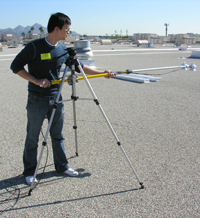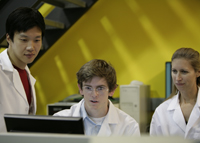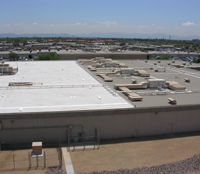May 28, 2010
Q&A with Jin Jo

Dr. Jo measuring sunlight reflectivity of a Phoenix-area rooftop.

Dr. Jo (left) working in the NCE Sustainable Materials and Renewable Technologies lab.

Visual comparison of a cool roof treatment (left) with a standard commercial rooftop (right).
Dr. Jo graduated from the School of Sustainability in May 2010 as the nation’s first Ph.D. in sustainability. His doctoral studies, chaired by School of Sustainability Assistant Professor Jay Golden, focused on the use of sustainable building strategies and renewable energy to reduce negative impacts of urbanization. This fall he will join the faculty of Illinois State University.
What inspired your interest in sustainability as an academic and research focus?
While pursuing a master’s in urban planning at Columbia University, I had the chance to study with Jeffrey Sachs and other faculty in the fields of environmental planning and sustainable development. Outside the classroom, I worked with local community groups such as Sustainable South Bronx. Both experiences stimulated my interest in creating mitigation strategies to reduce energy and material intensity, water consumption, and environmental impacts in cities. Faculty in the School of Sustainability furthered that interest by providing opportunities to work alongside local utility companies and city governments to develop and implement my ideas.
What are the most important sustainability-related projects you’ve been involved with at ASU?
In one project, I partnered with Arizona Public Service to model the electricity savings and environmental benefits from a cool roof system, using data I collected on the utility’s solar-reflective roof. For a project with the city of Chandler, I helped assess the feasibility of a photovoltaic system for the new city hall building by modeling several different available options and assessing the costs and energy production of each. On a follow-up project, I analyzed over 900 primarily commercial buildings in Chandler to assess the impacts of urban-scale photovoltaic installations. Finally, I developed a model that individually optimizes for each building the costs and benefits of cool roofs and renewable energy systems over entire life cycles.
How will your career work affect sustainability in the “real world”?
As a new faculty member in Illinois State University’s Renewable Energy Program and coordinator for the Center for Renewable Energy, I will enjoy unique opportunities to work with governments and industries to assess the impacts of urban-scale renewable energy applications. Results from this work will inform the decisions of utility companies and policymakers at many levels.
What is the world sustainability challenge that concerns you the most?
I believe the biggest sustainability challenge is to understand complex urban systems, particularly at the regional level. Major cities currently produce a significant impact on global and regional climate change due to their rapid population growth and physical expansion, but little is known about the regional effects of mitigation strategies. It is critical that we give city planners the knowledge and tools they need for assessing how different strategies can help them address energy consumption, water use, and environmental impacts.
May 28, 2010

